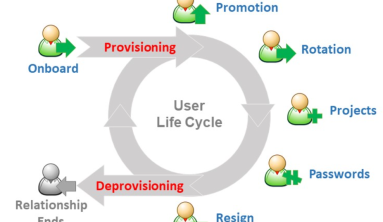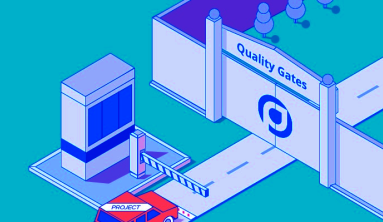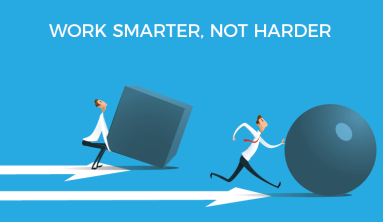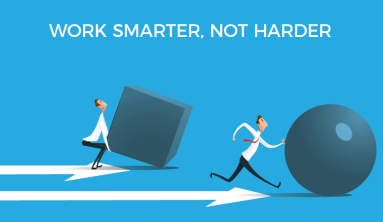
We don’t know whether every project manager can recall the exact moment they decided on their future profession. It may have been that they met a PM who passionately spoke about their work or maybe they saw a movie about some Wall Street shark (imagining their life would be just as exciting as it is on screen).
Nevertheless, once the profession is chosen most PMs will end up sticking to it. It’s said that after a while it sort of gets under your skin. It is hard to explain. Even though this job is highly stressful, and you can always hear a PM wining and swearing “when this quarter ends, I’m gone with the wind” – somehow, by the next quarter, his enthusiasm gets the best of them all over again.
To try and solve this mystery, we’ll go straight to the source. To a day in a PM’s life. One working day, of course (is there another kind?).
But let’s see if it’s true what they say.
Is being a PM actually something like this?
Being a Project Manager is like being an artist, you have the different colored process streams combining into a work of art.
– Greg Cimmarrusti
As a project manager, you may be responsible for one or, more often, several projects. This can bring a lot of stress and disrupt your work/life balance.
Also, it is not possible to do the same thing for two days in a row as a PM. There are days with a lot more stress when deadlines are approaching. At those times, the delivery management kicks in.
There is no time for a break until the tasks are done.
There are lower levels of stress and different kinds of activities when presenting to CEOs, meeting directors, or lecturing at workshops for business process improvement.
Managing projects or stress?
It is confirmed scientifically that project management is the most stressful job out there.
The success of the project depends on the stress levels of the manager.
If we look at the Yerkes-Dodson curve we can notice the following. Little levels of stress are expected for optimal performance. But everything above that can bring breakdown, in your job and even your family life.
Do not stay calm,
do not get distressed,
stay eustressed!
And this, my friend, is just a tip of the iceberg we are exploring now.
So, what are the factors that make this job so stressful, you may ask yourself? Maybe a deadline is looming and things are still not done. One of the workers is ill and had to leave the project suddenly.
Day-to-day requirements are making you dull. Or all of this together.
Ah, now you get the picture, right?
Scientists have found four different levels of stress that can take over a project manager. They were, of course, defined by an experienced project management consultant, Dr. Karl Albrecht. Here they are:
- Time stress – deliver the work in due time. Are you doing your best here?
- Situational stress – a serious situation without any sense of control: emergency, illness, losses of any kind
- Encounter stress – worry about encountering a person or situation that brought unpleasant feelings the previous time; based on previous experience
- Anticipatory stress – anticipation of some future events.
If you figure out another type, let us know!
Bottom line: a PM’s day almost never starts off easy. But the good news is, we know how to make it easier. Let’s see how.
Experienced project managers have come up with more than a few solutions.
Eating the frogs – 10% of the day
For the beginning of the day, there is a magic trick many PMs use. What better way is there to seize the day to the maximum? To come to work, drink the coffee, read the news and emails…
It’s even better if you are the first to come to the office and use all the calm time to get this done.
This way, you will avoid potential stressors attacking you unexpectedly. Put out the fire before it gets to the fire-burning-mode-kind-of-emails.
And you can draft plans for the whole day, too.
The phrase is known as “eat that frog”, meaning you should attack the hardest problems first or do first whatever you can assume might cause problems. Others simply call it drinking the coffee ritual.
You said music would work best for you?
Yes, music is great too.
After all, it doesn’t matter whether it is coffee, music, reading the assignments for the day, checking LinkedIn, Teodesk messages or anything else for that matter that will calm you down and assure you that you are ready for the day.
Some clients and even some managers prefer phone calls to emails. You will have to choose your own method and the best method for success between you and your client.
Once you have confirmed that there will be no unexpected troubles, we can move forward.
But, before all that – work on your energy resource. Use it wisely. Always try to achieve more by investing your attention wisely.
Group meetings – 20% of the day
You have made sure that you will start the day ready, but what about your team?
You will need to get them ready and prepared to enter their day too by confirming their assignments, and delegating the activities and plans for the day and potentially the whole week.
One way managers do it is through a scrum daily meeting.
Scrums are rapid 15-minute meetings where all the parties of the project are present. The most important daily plans are discussed, iterated and final plans confirmed.
It will save:
- Resources
- Time
- Mistakes
- Stress
Interestingly, they are also important for long-term sprint meetings and represent a crucial part.
The participants of the meeting will cover topics such as:
- Parts of the projects they finished yesterday
- Details on what each person will accomplish today
- The challenges of the project
Many technical or HR types of issues may occur and will need to be solved as soon as possible.
Of great assistance in this area may be software that will support not only project management but also the progress of the project.
Managing Projects or People – 40% of the day
PMs work with people on a day-to-day basis. This requires multiple soft skills.
1. Hiring new people
You may need to receive a new person and have an interview for a certain position. In those situations you are a psychologist, figuring out:
➔ Why are they making the transition?
➔ Why did they choose our company?
➔ Will they be a good addition to the existing team?
2. Managing conference calls
Some or many of your co-workers may be kilometers away. Conference calls are a very common type of communication for remote teams and they usually happen after the scrum meeting with local co-workers.
In many cases that is when, besides Skype, Join.me steps in.
As a project manager, you will mostly be in charge of hosting this kind of remote meeting. Conference call topics will be similar to scrum/sprint meetings where you will chat on previous and future work as well as troubleshooting.
More activities are linked to conference calls. The same is true for meetings in real-time.
This includes urgent actions – urgent emails, phone calls that will resolve the issue, updating project information (usually in the form of reports) as well as other emails, phone calls, and discussions for future actions.
3. Other soft skills
Additionally, you will have to chase people down on their deadlines, not just keep track of your own deadlines.
This is not an easy task.
You want all your team members to meet deadlines by motivating them, yet staying close to them as part of the team.
Quite challenging.
You need to be diplomatic with your colleagues and with your clients. In this scenario, you need to build friendships and communicate clearly the process of the project, from the beginning until the very end.
Until recently the project management role was stakeholder management. This explains a lot about the importance of this part of the job. Over time the idea of “managing stakeholders” evolved into “engaging stakeholders.” But the essence of the role is the same.
Among stakeholders there may be:
A. Quality control audits
B. Senior stakeholders
C. Board that approved some of the projects
Throughout the day there may be several meetings, phone calls, and presentations to a few or more of those stakeholders.
This is not all.
You will probably have to put slides into your slide deck, which may take even a week before the meeting. Often, there will be a need to send some form of follow-up information.
Relaxing – 10% of the day
After the initial rush, meetings, and fuss when the most important tasks have been done, the time is just right for chilling out.
This may be the most interesting and definitely a very important part of the workday of every project manager. It includes reading on relevant topics from multiple online resources. This supports the PM community and its social network with significant benefits.
These connections are made through Twitter, blogs, and inbox shares. Here are a few recommendations:
Keeping the Momentum of Projects – 20% of the day
In the middle of the day and as the end of the day is approaching, you want to be sure that you have gone over every single project and its current status.
Multiple problems may appear, such as project failure… This is not a rare event. Additionally, there may be sudden unexpected announcements from the upper management or even unexpected delays.
Project finances are crucial for any project. Sometimes the budget may be an issue. You may be spending too much and the budget review was not done properly. In those cases, you and the finance team will review the budget.
This happens for various reasons, but as a good manager, you need to know how to handle them and, more importantly, how to prevent this in your daily routine.
PMs often work alongside Product Managers to achieve the best results. They need to work in alignment, so the momentum of the project wouldn’t get lost.

Therefore, in order to maintain your success rate over the projects, you need to control them daily by:
- Going back and keeping the email correspondence ongoing.
- Reviewing all the notes from the meetings, including all troubleshooting.
- Learning and planning from them for future actions.
- Coordinating the resources.
- Meeting the specialists.
- Even though project managers are planners by nature of their jobs, it is possible that over the course of the day their focus, energy levels, and overall momentum drop.
It is important to know how to maintain it even when there are multiple projects and tasks for the whole day.
Is a typical PM day the same for all project management areas? Hmm…
All projects are different.
The people who work on them are different.
The organizations that conduct projects are organized and function differently.
It’s safe to say that the management of those projects will vary too.
There is project management in almost all areas of life. As the areas vary, we will expect that managing the projects and working with people in those different areas would give different flavors.
Even simple actions like taking a break or having lunch may have a different timeline and length in different projects and organizations.
1. Telecommunications Project Manager
Even though their working hours are from 9–5 p.m., the day starts long before that. When their surveyors are on-site, they will contact them early morning. This is necessary throughout the day in order to keep all schedules and plans on track.
2. Consultant Project Manager
Murray Bryant shared his experiences from his company, Capgemini. He compares the work of a PM with a consultant job, stressing that both have to come up with multiple solutions to a designated problem. A consultant will present his solutions to a client while a PM will report to his boss.
3. Engineering Project Manager
Douglas Walker shares his experiences as a Mechanical Engineer Project Manager. He shares that his day is spent 20–25 percent on average outside of the office.
An interesting thing he mentions is communication. There is a core belief that engineers can do the math, but often they fail in communication. Successful engineering PMs need communication skills or otherwise, everything else will not be worth anything.
4. IT Project Manager
Some interesting advice and insights have been presented by IT project managers. Basically, it’s this:
Exercise in the morning is a must as much as coffee is. Apparently, it’s smart to plan your day before as well during commuting. Starting early and mobilizing your whole team in order to break the day (and tasks) in two: before noon and after lunch – seems to have made some great results.
Use your lunch break to spend with a team member that is having a hard time. At the office or at home, no matter.
Always be as prepared for the meeting with the stakeholders, as the data you have allows you to.
When handling an unexpected announcement from the upper management – always first evaluate the impact of the announcement on the team’s activities, and then respond to it as quickly as possible.
Do the same when it comes to the unexpected delay, whatever that might be.
Have some time with your family. At dinner, if you can choose.
Before going to bed, plan some more – your next day, for example.
5. Mobile App Project Manager
Besides regular activities like “taking the vital signs of every project you work on” daily, being a Mobile App PM is so much more than being just a regular PM (although this might easily be an oxymoron, there is no such thing as a regular PM). First, you have to understand that in this field, you are always limited to technology that is available and your ability to utilize that technology.
The variables are infinite, and that is the blessing and the curse at the same time. There is no clear path that has been set before you. But, the good thing is that your job implies that it’s always something new, something different. So, be ready to face that every single day.
One of the most important tasks is to interact with everyone on the project, from designers to the development team. The eternal motivation source comes from this unity around one goal: turning ideas into reality!
And remember, the most important asset you need for this position is the ability to multitask! In a high speed!
Project Management and New Technology
We can thank technology that our life and work are so much easier now than they were some 20 or 30 years ago. As for project management – technology is to blame for that U-turn this field experienced. Advances in software, hardware, communication technology, and other areas have transformed the world of project management over the last few decades, and things just keep on changing.

But, which segments are affected (improved) most in today’s PM?
- Efficiency in the cloud – Cloud project management technology is cost-effective and easy to manage, it saves time and resources, while getting things done properly.
- Real-time updates and reporting – Not much to say here, the keyword is REAL-TIME!
- Mobile project teams – No one is constrained by their own location to work. Also, no one is constrained by the candidate’s location to gather a team. Pretty neat, right?
- Social collaboration – it’s easier than ever to make joint decisions and involve the whole team in achieving a common goal.
So, what can you do in times like this?
While there are many options, try looking for something that integrates all your activities and makes both your day-to-day decisions and long-term planning easier.
Source: teodesk.com









